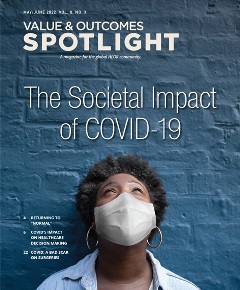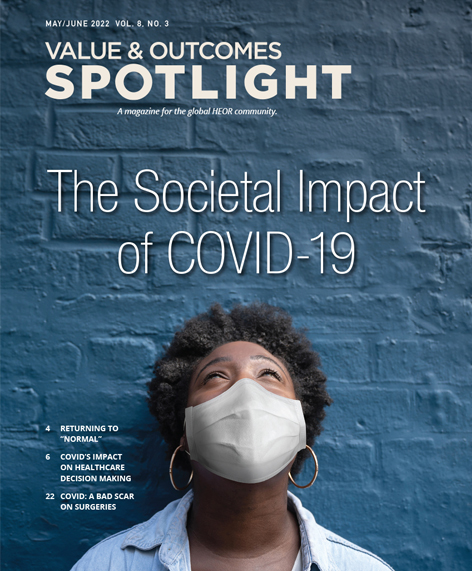The Societal Impact of COVID-19
Ilze Abersone, MS, Research Consultant, Vital Statistics Consulting, Hoboken, NJ, USA
 It had probably been at least a decade since I last took time off due to an illness. But then one day in early January, as Omicron was sweeping through the United States, I too received a positive PCR test result and became one of more than half a billion people worldwide who by May 2022 had gotten infected by SARS-CoV-2 virus.1 Being generally healthy and fully vaccinated, I was back on my feet after a couple of feverish days and a few weeks of what would be considered mild illness. Many, however, have been far less fortunate and have either directly experienced severe or long-term COVID-19, suffered from an overwhelmed healthcare system, or encountered great societal and economic consequences of this public health emergency. As we move into the third year of this pandemic, it is important to look back and evaluate the shortfalls and successes that could help us manage future infectious disease outbreaks.
It had probably been at least a decade since I last took time off due to an illness. But then one day in early January, as Omicron was sweeping through the United States, I too received a positive PCR test result and became one of more than half a billion people worldwide who by May 2022 had gotten infected by SARS-CoV-2 virus.1 Being generally healthy and fully vaccinated, I was back on my feet after a couple of feverish days and a few weeks of what would be considered mild illness. Many, however, have been far less fortunate and have either directly experienced severe or long-term COVID-19, suffered from an overwhelmed healthcare system, or encountered great societal and economic consequences of this public health emergency. As we move into the third year of this pandemic, it is important to look back and evaluate the shortfalls and successes that could help us manage future infectious disease outbreaks.
Where the healthcare system fell short during the pandemic
In the first half of 2020, the World Health Organization declared COVID-19 a global pandemic, and personal consumption expenditures on health services in the United States dropped by more than 30%.2 This was largely due to the disruption and cancellations of routine prescheduled examinations and preventive procedures. Many healthcare professionals, including Ethan Chapin, MD, an emergency medicine physician and Director of the Urgent Care and Occupational Health at Colley Dickinson Health Care in Amherst, MA, USA, are worried that consequences of this (mostly) outpatient care disruption could have a catastrophic long-term impact on the population. “If you delay screening exams or checkups for a 2-year pandemic, that’s 2 years during which a stage 1 cancer can go to stage 4. In the worst-case scenarios, this delay is between life or death.” Two years later, although improving, we still have not fully returned to the pre-pandemic levels for these preventive procedures, and the National Cancer Institute predicts that by 2030 forgone colonoscopies and mammograms may cause up to 10,000 excess colorectal and breast cancer deaths, potentially turning one public health crisis into others.3
“If you delay screening exams or checkups for a 2-year pandemic, that’s 2 years during which a stage 1 cancer can go to stage 4. In the worst-case scenarios, this delay is between life or death.” — Ethan Chapin, MD
The COVID-19 pandemic has also exposed weaknesses in our healthcare system and emergency preparedness. “The US healthcare system is not designed to accommodate large numbers of high-acuity patients or patients with severe end-stage disease entering the system all at once,” explains Chapin. We most noticeably saw this during the first wave of infections, but the risk of overcrowded intensive care units (ICUs) and emergency rooms still persists with the appearance of every new SARS-CoV-2 variant. However, it’s not just the patients that suffer. Chapin points out that in addition to the space constraints and shortage of equipment for critically ill patients, there was a great psychological and emotional toll imposed on healthcare workers due to the lack of personal protective equipment (PPE). “Being told that the hospital couldn’t acquire it, we had to reach out to friends and family for any N95s that they might have. My dad sent me some old masks that he had saved up for woodworking.” In fact, 93% of healthcare provider executives reported that they experienced supply chain shortages4 and most of these providers are now preparing for increased spending on tools that could help foresee and manage any future large-scale disease outbreaks.
Predictive modeling as a tool during an evolving public health emergency
As COVID-19 was spreading across the globe, many analysts and statisticians were rushing to create dynamic epidemiological models that could predict infection and vaccination rates, mortality, ICU capacity, as well as the effect of public health mitigation measures on the viral spread containment. Generally, these forecasts have improved over time and can paint a fairly accurate picture of healthcare resource capacity, but Jessica Steier, DrPH, CEO of Vital Statistics Consulting and Cofounder of the Unbiased Science Institute in Amherst, MA, USA, admits that such models are only useful to an extent because “there are variables that impact how realistic they can be. We are dealing with a completely novel virus that is mutating and each variant is behaving differently in terms of infection rates and disease severity.” However, it’s not all about the virus itself. Another major barrier to creating accurate models is human behavior. We have seen throughout the pandemic that individual behavior matters—and it can greatly affect the rate at which an infection spreads. Standard SIR models, which divide populations into “Susceptible,” “Infectious,” and “Recovered,” are often used in other infectious disease (eg, influenza) evaluations, but they fall short in capturing rates that continuously change in response to both pandemic fatigue and local and federal government actions. More importantly, Steier adds that, “Not only are you dealing with differences across individuals, but also within individuals over time. People are getting burned out in terms of mitigation measures.” Compliance with nonpharmaceutical interventions is challenging to predict with great accuracy using current modeling methods. Therefore, many stakeholders have been pushed to investing in more sophisticated predictive forecasting that, among other methods, utilizes machine learning for policy evaluation and decision making.
“Not only are you dealing with differences across individuals, but also within individuals over time. People are getting burned out in terms of mitigation measures.” — Jessica Steier, DrPH
While epidemiologists rightfully have been at the forefront of COVID-19, health economists too have played a major role in evaluating the impact of this pandemic. Governments around the world have been pouring an unprecedented amount of financial relief into the healthcare sector to prevent it from collapsing. For example, it is estimated that on average, a COVID-19–associated hospitalization in the United States costs anywhere from $20,000 to $25,000, imposing a huge economic burden on both private payers and the government. In addition, in the second half of 2021, preventable hospitalizations among the unvaccinated population alone cost nearly $14 billion.5
“Often in public health we focus on health outcomes in terms of morbidity and mortality, but it’s important to look at the major economic, mental health, and employment impacts because they have real-life implications.” — Jessica Steier, DrPH
With vaccinations widely available and various therapeutics in the pipeline, payers are turning to comparative cost-effectiveness models for intervention decision making. However, more evidence increasingly points to the fact that recovering from COVID-19 is more complex than initially thought. Lingering health effects of postacute sequelae of SARS-CoV-2 infection are common and can affect one’s productivity and wellness long-term.
Looking beyond the effect on healthcare and planning ahead
It is important to recognize that the response to the COVID-19 pandemic has involved a lot more than just the healthcare sector. In fact, there likely isn’t a single socioeconomic system that was not in one way or another affected by the extraordinary amount of mitigation measures and restrictions imposed by local and national governments. As administrations were dealing with the tradeoffs between health and economic implications, it created an immediate negative effect on labor market, education, housing, environment, and many other social sectors. It is therefore important to recognize and evaluate the broader societal impact of this pandemic. “Often in public health we focus on health outcomes in terms of morbidity and mortality, but it’s important to look at the major economic, mental health, and employment impacts because they have real-life implications,” said Steier. Losing your job or working from home while having to oversee the schoolwork for your children is likely to create not only physical burnout, but also emotional exhaustion, substance abuse, and even domestic violence, leaving significant long-term impacts on quality of life.
While it will take a while to fully evaluate and understand both the health and economic burdens that this pandemic has imposed on our society, there are some steps that health economics can take now to plan for the future. For example, we need cross-sectional approaches that evaluate health and social factors, as well as the economic impact and burden on both the healthcare system and individuals. It is important to look at comparative cost-effectiveness of both pharmaceutical and nonpharmaceutical interventions because we have to understand the health and economic outcomes of the various vaccination programs.
Growing sentiment of distrust in the scientific establishment is a major issue that has increased vaccine hesitancy among certain populations and calls for community-based approaches. Steier recognizes that in these instances, scientific communication has to occur through grassroots local efforts, local communities, and community-based organizations in order to yield better outcomes. In fact, previous studies have shown that peer-to-peer education about vaccinations can result in higher rates of vaccine uptake. In addition to healthcare interventions and evaluations, quality-of-life studies are needed to understand the patient perspective and their expectations.
The field of health economics and outcomes research has all the tools needed to assist in evidence generation either through real-world evidence, retrospective data analysis, patient voices, or some other mechanism. Applying these insights to stakeholder decisions and policy making would bring us closer to evidence-based decision making in the future.
References:
1. Johns Hopkins University. COVID-19 Dashboard. Accessed May 6, 2022. https://coronavirus.jhu.edu/map.html
2. Cox C, Amin K, Kamal R. How have health spending and utilization changed during the coronavirus pandemic? Peterson-KFF Health System Tracker. 2021. Accessed May 6, 2022. https://www.healthsystemtracker.org/chart-collection/how-have-healthcare-utilization-and-spending-changed-so-far-during-the-coronavirus-pandemic/
3. Sharpless NE. COVID-19 and cancer. Science. 2020; 368(6497):1290. doi:10.1126/science.abd3377.
4. PwC Health Research Institute. Medical cost trend: Behind the numbers 2022. Accessed May 6, 2022. https://www.pwc.com/us/en/industries/health-industries/library/assets/pwc-hri-behind-the-numbers-2022.pdf
5. Amin K, Cox C. Unvaccinated COVID-19 hospitalizations cost billions of dollars. Peterson-KFF Health System Tracker. 2021. Accessed May 6, 2022. https://www.healthsystemtracker.org/brief/unvaccinated-covid-patients-cost-the-u-s-health-system-billions-of-dollars/

